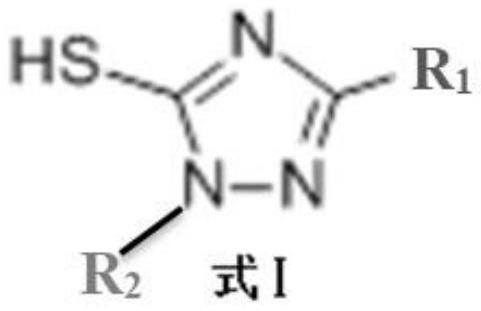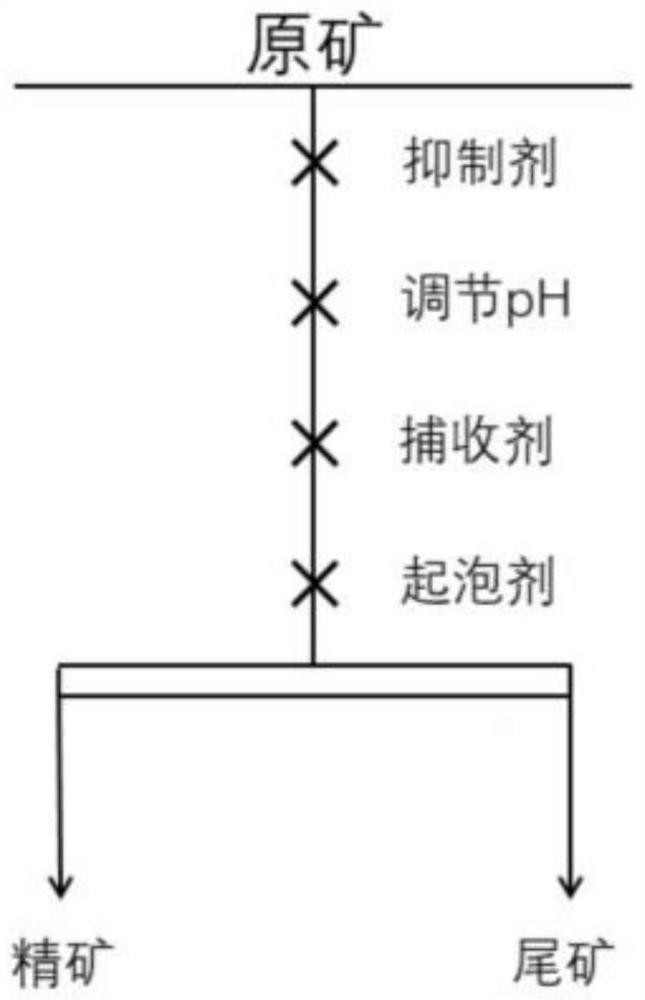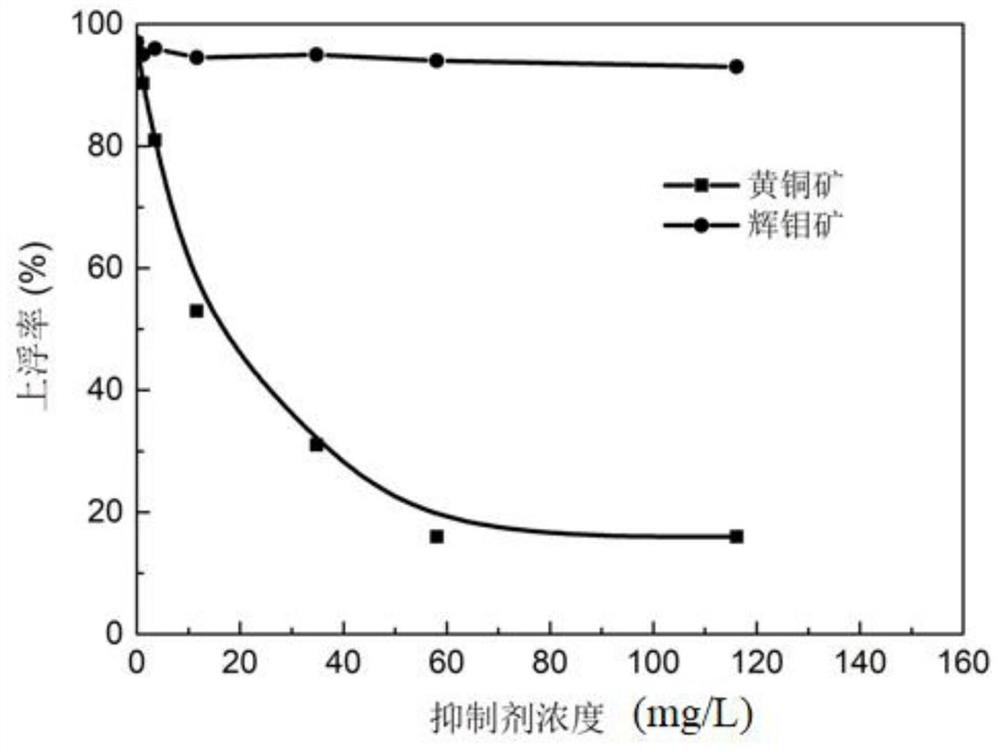A copper-molybdenum separation inhibitor and its application and application method
An inhibitor, copper-molybdenum technology, applied in solid separation, flotation and other directions, can solve the problems of large dosage of chemicals, low recovery rate of molybdenum, environmental pollution, etc., achieving no irritating odor, good inhibition effect, and strong selectivity Effect
- Summary
- Abstract
- Description
- Claims
- Application Information
AI Technical Summary
Problems solved by technology
Method used
Image
Examples
Embodiment 1
[0033] Take 1 g of molybdenite and chalcopyrite single minerals of 38-74 μm respectively and mix them uniformly at a ratio of 1:1, add 50 mL of distilled water into a 70 mL hanging tank flotation machine, and stir and adjust the slurry at 1300 r / min. Let the pulp be fully dispersed, adjust the pH to 10 after adding the inhibitor, stir for 5 min, add kerosene and stir for 2 minutes, add foaming agent A200 and stir for 1 min, the inhibitor (R 1 is thiol, R 2 The concentration of amine group is 400mg / L, the concentration of collector is 20mg / L, and the concentration of foaming agent is 20mg / L. After the stirring is completed, aeration flotation is performed to obtain foam products and tailings. Dry the foam product and tailings separately, weigh and test the molybdenum and copper content in the concentrate, and calculate the recovery rate of molybdenum and copper in the concentrate. It is calculated that the floating rate of molybdenite is 90%, and the floating rate of chalcopy...
Embodiment 2
[0035] Take 1g of molybdenite and pyrite single minerals of 38-74μm and mix them uniformly at a ratio of 1:1, add 50mL of distilled water to a 70mL hanging tank flotation machine, and stir and adjust the slurry at 1300r / min. Let the pulp be fully dispersed, adjust the pH to 9 after adding the inhibitor, stir for 5 minutes, add diesel oil and stir for 2 minutes, add the foaming agent BK-401 and stir for 1 minute, the inhibitor (R 1 is amino, R 2 The concentration of sulfhydryl group is 200mg / L, the concentration of collector is 20mg / L, and the concentration of foaming agent is 20mg / L. After the stirring is completed, aeration flotation is performed to obtain foam products and tailings. Dry the foam product and tailings separately, weigh and test the molybdenum and iron content in the concentrate, and calculate the recovery rate of molybdenum and iron in the concentrate. It is calculated that the floating rate of molybdenite is 94.8%, and the floating rate of the pyrite is 5%....
Embodiment 3
[0037] Take 1g of molybdenite and galena single minerals of 38-74μm and mix them uniformly at a ratio of 1:1, add 50mL of distilled water to a 70mL hanging tank flotation machine, and stir and adjust the slurry at a speed of 1300r / min. Let the pulp be fully dispersed, adjust the pH to 10 after adding the inhibitor, stir for 5 minutes, add kerosene and stir for 2 minutes, add the foaming agent and stir for 1 minute, the inhibitor (R 1 Amino, R 2 is mercapto group, ) concentration is 400mg / L, collector concentration is 20mg / L, foaming agent concentration is 20mg / L, and described foaming agent is MIBC, A200, BK-401 mixed according to mass ratio 31:22:47 the mixture after. After the stirring is completed, aeration flotation is performed to obtain foam products and tailings. Dry the foam product and tailings separately, weigh and test the molybdenum and lead content in the concentrate, and calculate the recovery rate of molybdenum and lead in the concentrate. It is calculated th...
PUM
 Login to View More
Login to View More Abstract
Description
Claims
Application Information
 Login to View More
Login to View More - R&D
- Intellectual Property
- Life Sciences
- Materials
- Tech Scout
- Unparalleled Data Quality
- Higher Quality Content
- 60% Fewer Hallucinations
Browse by: Latest US Patents, China's latest patents, Technical Efficacy Thesaurus, Application Domain, Technology Topic, Popular Technical Reports.
© 2025 PatSnap. All rights reserved.Legal|Privacy policy|Modern Slavery Act Transparency Statement|Sitemap|About US| Contact US: help@patsnap.com



